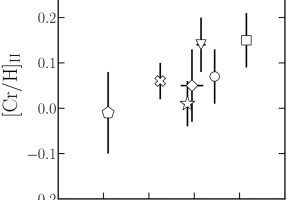Stellar parameters and chemical abundances from GAPS. The study: “The GAPS Programme at TNG XXV. Stellar atmospheric parameters and chemical composition through GIARPS optical and near-infrared spectra” of M. Baratella (UniPd) recently appeared on A&A

Several astronomical studies rely on the precise determination of the chemical abundances of stars. For instance, the determination of chemical abundances of stars in different sites of the Milky Way, or with different age or evolutionary phase, can provide precious information on the evolution of our Galaxy. However, recently it has been discovered that spectroscopic determination of stellar chemical abundances may be affected by the stellar magnetic activity. This issue becomes more serious in very young stars (a few hundreds million years old), which are more active than older stars. For instance, recent studies have shown that in specific young stars claimed to have lower abundances of heavy elements with respect to the Sun, this result is likely due to the overestimation of a parameter describing the average velocity of microturbulences in the photosphere, and that the intensity of the lines of some elements, such as Iron, used to evaluate their abundances, vary during the stellar activity cycle.
Today, spectroscopic studies of large samples of stars are possible thanks to rich databases of high-resolution spectroscopic observations are available for the scientific community. For instance, databases are available from the project GAPS (Global Architecture of Planetary Systems), which aims at characterizing known exoplanetary systems thanks to observations with the spectrographs Harps-N in optical and GIANO-B in infrared, both mounted on the Italian Telescope “Telescopio Nazionale Galileo”, from the Gaia-ESO Survey based on FLAMES@ESO observations, or from the GALAH survey based on observations with the HERMES spectrograph, mounted on the Mercator Telescope.
The team led by the astronomer M. Baratella (University of Padua) analyzed the high-resolution spectra, acquired in the framework of the GAPS project, of seven GAPS targets, the Sun, and two radial-velocity standards, with the aim of measuring their abundances. The team has shown that the abundances of some ionized elements, such as Cr II, increase with decreasing the stellar temperature, likely for an effect of over-ionization. Besides, the abundances of some elements such as Carbon correlate with some indices measuring the magnetic activity of the stars, so that the abundances are higher in more active stars. The results of the study are shown in the article: “The GAPS Programme at TNG XXV. Stellar atmospheric parameters and chemical composition through GIARPS optical and near-infrared spectra“, recently appeared on the journal Astronomy & Astrophysics. Among the coauthors, the astronomers S. Benatti, J. Maldonado, and G. Micela from INAF – Astronomical Observatory of Palermo.
The image (click here to visualize the entire image) shows the correlation between the abundace of Cr II over Hydrogen and the index log(RHK), the latter measuring the intensity of stellar activity.
Mario Giuseppe Guarcello ( follow mguarce)
